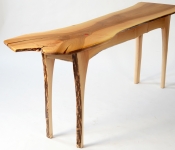Artist Bio
Peter Dellert’s college degree is in biology. He was going to be an oceanographer and then a lichenologist. Since then, Dellert has worked as a cook, a shipwright, a potter, a builder, a cabinetmaker, and finally a furniture maker.
His work continues to change and evolve from functional tables and wall cabinets to sculptures and mixed media pieces that are often narrative.
While Peter is inspired by, both, nature and the built environment, often it is a process such as mending or weathering that sparks new work.
Artist Statement
An ongoing series of minimalist collages presents cut up leaves as grids inlaid in painted fields. Inspired by the work of Albers and Klee, I seek to explore color and texture contrasts with a material that is seductive yet mysterious, in that is has been deconstructed and then reconfigured in such a way as to loose its identity.
The Reservoir Map series pieces use botanical elements (leaves, bark, etc.) mixed with printed papers, old maps, and other materials to define personal narrative geographies.
In the last few years, I have been developing a series of sculptures based on biomorphic forms. Inspired by seeds, shells, and pods, some existing, some extinct, some imagined, these forms are reduced to a minimal essence while still allowing multiple interpretations. Often their hidden interior forms and content are hinted at, with seam lines and openings, while surface treatments vary from fabricated wood, twigs and branches to tin cans, plaster and cement.
While the forms seem familiar, the scale and the surface treatments may appear strange and of another world. This gives them an intriguing, exotic and captivating stance, involving the viewer, and provoking reflection on content and meaning..
While I am inspired by both nature and the built environment, often it is a process such as mending or weathering that sparks new work.
Many recent furniture pieces are meticulously joined mixed media wall cabinets using techniques that include natural and polychromed woods, veneers, carving, patinated metals, gold leaf, collaged paper, found objects and integral lighting.
They are often narrative, using themes both personal and universal. They involve the viewer when closed as sculpture and when open reveal additional layers of meaning.
I also design and build a series of Canyon Tables using bookmatched live edged slabs from native, often local woods such as curly maple, cherry, walnut and ash.
Joined only at the ends, the tops of the tables have a gap, or negative space in the center which can be looked through and provides a lightness to an otherwise very sturdy piece.
The legs are either sculpted and polychromed basswood or turned and ebonized cherry.
Photography: Juris Mardwig



